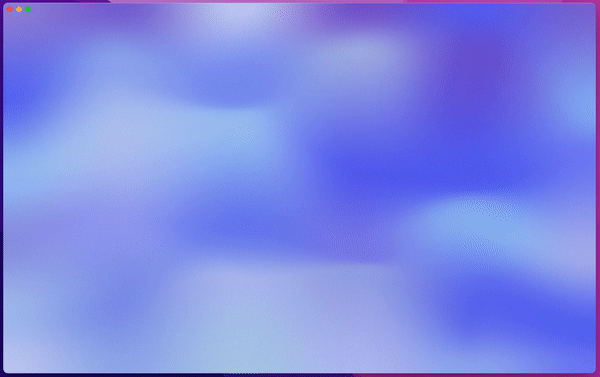Metal-based implementation of beautiful mesh gradient. Image worth thousands of words, so just let me show you.
Small notes before I show you the code. This mesh is generated from the constants you provide. To create mesh you have to provide grid with ControlPoint matrix that describe your gradient (just like with other gradients, huh?):
- You need to provide
colorsfor gradient - that is obvious, right? - You need to provide
locations of control points. Locations are in metal coordinate space - that one is a bit scarier. Relax, it is just values in -1...1 - You need to provide how turbulent your mesh is. This is
uTangentandvTangentexists for.
Again, don't be scared. You have all the randomizers out of the box and they are pretty easy to use.
Now, to the code:
typealias MeshColor = SIMD3<Float>
// You can provide custom `locationRandomizer` and `turbulencyRandomizer` for advanced usage
var meshRandomizer = MeshRandomizer(colorRandomizer: MeshRandomizer.arrayBasedColorRandomizer(availableColors: meshColors))
private var meshColors: [simd_float3] {
return [
MeshRandomizer.randomColor(),
MeshRandomizer.randomColor(),
MeshRandomizer.randomColor(),
]
}
// This methods prepares the grid model that will be sent to metal for rendering
func generatePlainGrid(size: Int = 6) -> Grid<ControlPoint> {
let preparationGrid = Grid<MeshColor>(repeating: .zero, width: size, height: size)
// At first we create grid without randomisation. This is smooth mesh gradient without
// any turbulency and overlaps
var result = MeshGenerator.generate(colorDistribution: preparationGrid)
// And here we shuffle the grid using randomizer that we created
for x in stride(from: 0, to: result.width, by: 1) {
for y in stride(from: 0, to: result.height, by: 1) {
meshRandomizer.locationRandomizer(&result[x, y].location, x, y, result.width, result.height)
meshRandomizer.turbulencyRandomizer(&result[x, y].uTangent, x, y, result.width, result.height)
meshRandomizer.turbulencyRandomizer(&result[x, y].vTangent, x, y, result.width, result.height)
meshRandomizer.colorRandomizer(&result[x, y].color, result[x, y].color, x, y, result.width, result.height)
}
}
return result
}// If you want just show static grid without any animations
struct MyStaticGrid: View {
var body: some View {
MeshGradient(grid: generatePlainGrid())
}
}
struct MyAnimatedGrid: View {
// MeshRandomizer is a plain struct with just the functions. So you can dynamically change it!
@State var meshRandomizer = MeshRandomizer(colorRandomizer: MeshRandomizer.arrayBasedColorRandomizer(availableColors: meshColors))
var body: some View {
MeshGradient(initialGrid: generatePlainGrid(),
animatorConfiguration: .init(animationSpeedRange: 2 ... 4, meshRandomizer: meshRandomizer)))
}
}Use MTKView and MetalMeshRenderer. I hope you have minimal knowledge in metal rendering. Good luck ;)
Check source code of SwiftUI MeshGradient implementation that just wraps MTKView.
